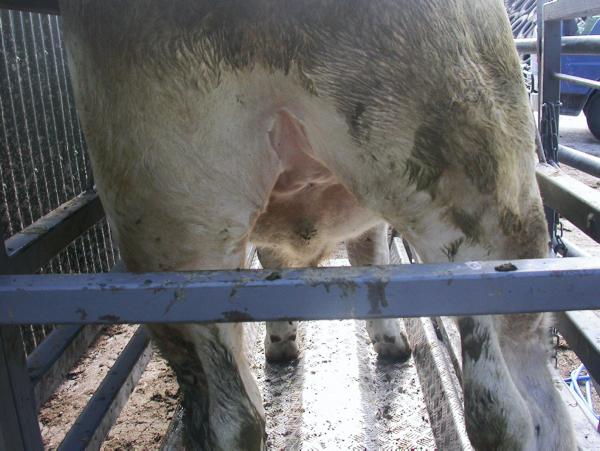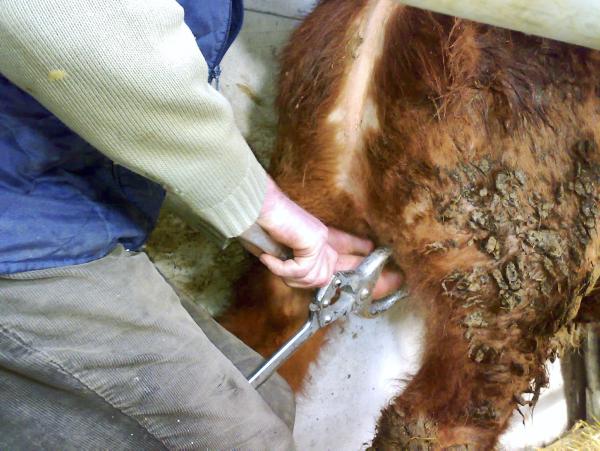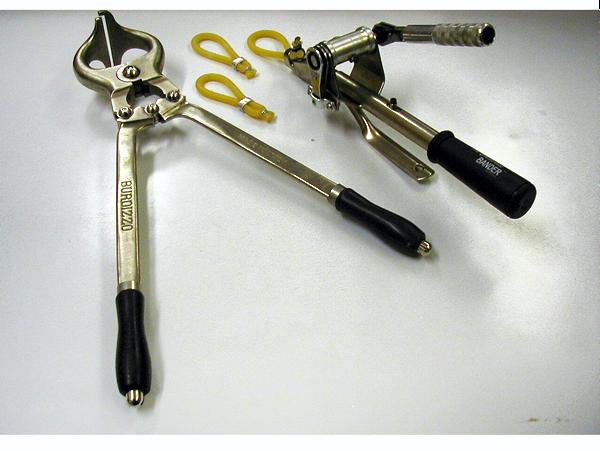With many farmers now weighing up the options for finishing male cattle as bulls or steers, the whole area of castration is being considered much more than has been the case in recent years. From a production point of view, castration has some advantages and disadvantages:
Advantages:
Steers are generally easier to handle safely;Castration eliminates unwanted sexual activity – the chance of accidental matings; Steers are less susceptible to stress and generally have less carcase quality issues, e.g. dark cutting meat;Bulls require specific handling requirements to prevent injury stress to animals within the group.Disadvantages
Bulls have a faster growth rate with leaner carcases;Entire animals often have greater feed conversion efficiency;All castration methods have risks attached to them.Here, we outline the options available to farmers for castrating their bulls. In Ireland, it is important to note that it is illegal to castrate a bull over six months of age without using a local anaesthetic.
In contrast, in Britain, castration of calves without use of anaesthesia must be done before they reach two months of age.
By law, a local anaesthetic can only be administered by a vet or by a person under the direct supervision of a vet.
Castration can sometimes incorrectly be considered a routine procedure with little risk. It is important to remember that castration, particularly of older calves/bulls, carries some risk and the correct procedure/method should be used.
Rubber rings
This is a simple method of castration and, from a welfare viewpoint (of man and beast), is probably the best. Calves less than one week of age are suitable for this procedure where a rubber ring is placed on the scrotum above the two testicles and this restricts the blood flow to the testicles.
It is important to make sure both testicles are in the scrotum and that a new, clean ring is used each time. Complications with this procedure are generally less than with other methods of castration. If the calf is destined to be finished on the farm as a steer, this method should be strongly considered.
Some farmers worry about reduced growth rates but, over the lifetime of the steer, this has been shown to be insignificant and the benefits of this method (no mis-matings, safer to handle, decreased complications) are not always taken into account.
Tetanus can be a risk with this method but if the cows are vaccinated against tetanus and the calves get adequate colostrum, this should not be a problem.

Burdizzo
(bloodless castration)
This is the method of castration that is most likely to fail, if not completed correctly, as one or both testicles can be missed. In the right hands, the burdizzo can offer a quick and simple method of castration. To reduce the risk of failure, the following points should be followed:
Do not squeeze bulls that are too strong. This is a recipe for disaster. It is impossible to give an exact age when bulls become too strong for squeezing as this depends on breed and feeding but a trained operator will know. Squeezing strong bulls can result in serious complications (swelling, infection and abcessation) and, from a welfare point of view, this is not acceptable. Generally, in bulls under six months, this is a good method but it needs to be completed by a trained operative. Incorrect placement of the burdizzo can result in serious problems.Keep everything clean. It is important to make sure that both the burdizzo and the scrotum are clean when squeezing bulls. The risk of infection is real and all efforts should be made to reduce this. An iodine surgical scrub can prevent a lot of problems down the road.Storing the burdizzo. The burdizzo is a precise instrument where the crushing force is enough to crush the blood flow to the testicle but not break the skin of the scrotum. When not in use, the burdizzo should be stored in the open position. Storing them closed will result in the tension being reduced and they may not be effective as a result.Banding
(bloodless castration)
This method has become increasingly popular in recent years to castrate bull weanlings. The principle is basically the same as the use of a rubber ring in young calves where the blood flow to the testicles is restricted and, over time, the testicles wither. Vets and farmers alike have their own opinions on this option with some favouring it over surgical castration/squeezing and some not. It depends on the age of the bulls, the time of year, and management systems on the farm.
It is vital that this procedure is completed by a trained operative to ensure both testicles are captured and the band is placed in the correct position.
Incorrect placement of the band can cause serious problems and, again, hygiene is important to reduce the likelihood of infection. Some farmers report greater recovery times for the animal after banding versus surgical castration, while others don’t.

As with all methods, the less mature the testicles are at the time of castration, the better. While not as high as with surgical castration, the risk of tetanus is real with banding and it is advisable that all animals are vaccinated for tetanus prior to castration.
Surgical castration
This method is the most certain technique for castration (physical removal of testicles) but it comes with potential complications, such as infection and haemorrhage. It should only be performed by your vet and is particularly useful in the castration of older bull weanlings.
The scrotum is incised and both testicles are removed. Different vets use different methods to control bleeding (emasculators, twist and pull, ligatures). Hygiene both during and after the procedure is obviously vital. The cleanest place for the animals after the procedure is a dry pasture to reduce the likelihood of infection.
Many farmers like this option for castration and report short recovery times for the animals after the procedure. Tetanus is a real risk with this open surgical method and all animals should be vaccinated against tetanus prior this procedure.
The later castration is left, the greater the chances of complications. If the animal is destined to be finished as a steer on the farm, early castration is advised. No method of castration is without the risk of complications but the longer it is left, the greater the risk.Over the lifetime of a steer, the benefits of delayed castration in relation to both growth rates and finishing age are minimal or often non-existent.Tetanus is a real risk, especially in castrating older animals. Tetanus vaccination is often incorporated along with vaccination for other clostridial diseases (eg blackleg) and is relatively inexpensive.Do not enter into castrating large numbers of older animals without first planning it. Vaccination and how the animals are going to be handled after banding/surgical castration are important.The use of painkillers should be considered and advice on this can be sought from your vet.The best castration method to be used on your farm will depend on a number of factors, such as the age of the animals and the time of year (housed animals versus animals at grass).Advice on the correct method of castration for your animals should be sought. Farmers wishing to castrate older animals originally destined for bull beef systems should consider this carefully. Inappropriate methods of castration for older animals can have serious consequences and advice from your vet should be sought in every situation. Read more
Beef management notes
With many farmers now weighing up the options for finishing male cattle as bulls or steers, the whole area of castration is being considered much more than has been the case in recent years. From a production point of view, castration has some advantages and disadvantages:
Advantages:
Steers are generally easier to handle safely;Castration eliminates unwanted sexual activity – the chance of accidental matings; Steers are less susceptible to stress and generally have less carcase quality issues, e.g. dark cutting meat;Bulls require specific handling requirements to prevent injury stress to animals within the group.Disadvantages
Bulls have a faster growth rate with leaner carcases;Entire animals often have greater feed conversion efficiency;All castration methods have risks attached to them.Here, we outline the options available to farmers for castrating their bulls. In Ireland, it is important to note that it is illegal to castrate a bull over six months of age without using a local anaesthetic.
In contrast, in Britain, castration of calves without use of anaesthesia must be done before they reach two months of age.
By law, a local anaesthetic can only be administered by a vet or by a person under the direct supervision of a vet.
Castration can sometimes incorrectly be considered a routine procedure with little risk. It is important to remember that castration, particularly of older calves/bulls, carries some risk and the correct procedure/method should be used.
Rubber rings
This is a simple method of castration and, from a welfare viewpoint (of man and beast), is probably the best. Calves less than one week of age are suitable for this procedure where a rubber ring is placed on the scrotum above the two testicles and this restricts the blood flow to the testicles.
It is important to make sure both testicles are in the scrotum and that a new, clean ring is used each time. Complications with this procedure are generally less than with other methods of castration. If the calf is destined to be finished on the farm as a steer, this method should be strongly considered.
Some farmers worry about reduced growth rates but, over the lifetime of the steer, this has been shown to be insignificant and the benefits of this method (no mis-matings, safer to handle, decreased complications) are not always taken into account.
Tetanus can be a risk with this method but if the cows are vaccinated against tetanus and the calves get adequate colostrum, this should not be a problem.

Burdizzo
(bloodless castration)
This is the method of castration that is most likely to fail, if not completed correctly, as one or both testicles can be missed. In the right hands, the burdizzo can offer a quick and simple method of castration. To reduce the risk of failure, the following points should be followed:
Do not squeeze bulls that are too strong. This is a recipe for disaster. It is impossible to give an exact age when bulls become too strong for squeezing as this depends on breed and feeding but a trained operator will know. Squeezing strong bulls can result in serious complications (swelling, infection and abcessation) and, from a welfare point of view, this is not acceptable. Generally, in bulls under six months, this is a good method but it needs to be completed by a trained operative. Incorrect placement of the burdizzo can result in serious problems.Keep everything clean. It is important to make sure that both the burdizzo and the scrotum are clean when squeezing bulls. The risk of infection is real and all efforts should be made to reduce this. An iodine surgical scrub can prevent a lot of problems down the road.Storing the burdizzo. The burdizzo is a precise instrument where the crushing force is enough to crush the blood flow to the testicle but not break the skin of the scrotum. When not in use, the burdizzo should be stored in the open position. Storing them closed will result in the tension being reduced and they may not be effective as a result.Banding
(bloodless castration)
This method has become increasingly popular in recent years to castrate bull weanlings. The principle is basically the same as the use of a rubber ring in young calves where the blood flow to the testicles is restricted and, over time, the testicles wither. Vets and farmers alike have their own opinions on this option with some favouring it over surgical castration/squeezing and some not. It depends on the age of the bulls, the time of year, and management systems on the farm.
It is vital that this procedure is completed by a trained operative to ensure both testicles are captured and the band is placed in the correct position.
Incorrect placement of the band can cause serious problems and, again, hygiene is important to reduce the likelihood of infection. Some farmers report greater recovery times for the animal after banding versus surgical castration, while others don’t.

As with all methods, the less mature the testicles are at the time of castration, the better. While not as high as with surgical castration, the risk of tetanus is real with banding and it is advisable that all animals are vaccinated for tetanus prior to castration.
Surgical castration
This method is the most certain technique for castration (physical removal of testicles) but it comes with potential complications, such as infection and haemorrhage. It should only be performed by your vet and is particularly useful in the castration of older bull weanlings.
The scrotum is incised and both testicles are removed. Different vets use different methods to control bleeding (emasculators, twist and pull, ligatures). Hygiene both during and after the procedure is obviously vital. The cleanest place for the animals after the procedure is a dry pasture to reduce the likelihood of infection.
Many farmers like this option for castration and report short recovery times for the animals after the procedure. Tetanus is a real risk with this open surgical method and all animals should be vaccinated against tetanus prior this procedure.
The later castration is left, the greater the chances of complications. If the animal is destined to be finished as a steer on the farm, early castration is advised. No method of castration is without the risk of complications but the longer it is left, the greater the risk.Over the lifetime of a steer, the benefits of delayed castration in relation to both growth rates and finishing age are minimal or often non-existent.Tetanus is a real risk, especially in castrating older animals. Tetanus vaccination is often incorporated along with vaccination for other clostridial diseases (eg blackleg) and is relatively inexpensive.Do not enter into castrating large numbers of older animals without first planning it. Vaccination and how the animals are going to be handled after banding/surgical castration are important.The use of painkillers should be considered and advice on this can be sought from your vet.The best castration method to be used on your farm will depend on a number of factors, such as the age of the animals and the time of year (housed animals versus animals at grass).Advice on the correct method of castration for your animals should be sought. Farmers wishing to castrate older animals originally destined for bull beef systems should consider this carefully. Inappropriate methods of castration for older animals can have serious consequences and advice from your vet should be sought in every situation. Read more
Beef management notes








 This is a subscriber-only article
This is a subscriber-only article











SHARING OPTIONS: